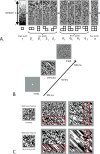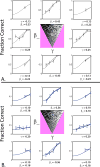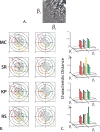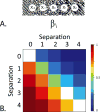Two representations of a high-dimensional perceptual space
- PMID: 28549921
- PMCID: PMC6002902
- DOI: 10.1016/j.visres.2017.05.003
Two representations of a high-dimensional perceptual space
Abstract
A perceptual space is a mental workspace of points in a sensory domain that supports similarity and difference judgments and enables further processing such as classification and naming. Perceptual spaces are present across sensory modalities; examples include colors, faces, auditory textures, and odors. Color is perhaps the best-studied perceptual space, but it is atypical in two respects. First, the dimensions of color space are directly linked to the three cone absorption spectra, but the dimensions of generic perceptual spaces are not as readily traceable to single-neuron properties. Second, generic perceptual spaces have more than three dimensions. This is important because representing each distinguishable point in a high-dimensional space by a separate neuron or population is unwieldy; combinatorial strategies may be needed to overcome this hurdle. To study the representation of a complex perceptual space, we focused on a well-characterized 10-dimensional domain of visual textures. Within this domain, we determine perceptual distances in a threshold task (segmentation) and a suprathreshold task (border salience comparison). In N=4 human observers, we find both quantitative and qualitative differences between these sets of measurements. Quantitatively, observers' segmentation thresholds were inconsistent with their uncertainty determined from border salience comparisons. Qualitatively, segmentation thresholds suggested that distances are determined by a coordinate representation with Euclidean geometry. Border salience comparisons, in contrast, indicated a global curvature of the space, and that distances are determined by activity patterns across broadly tuned elements. Thus, our results indicate two representations of this perceptual space, and suggest that they use differing combinatorial strategies.
Significance statement: To move from sensory signals to decisions and actions, the brain carries out a sequence of transformations. An important stage in this process is the construction of a "perceptual space" - an internal workspace of sensory information that captures similarities and differences, and enables further processing, such as classification and naming. Perceptual spaces for color, faces, visual and haptic textures and shapes, sounds, and odors (among others) are known to exist. How such spaces are represented is at present unknown. Here, using visual textures as a model, we investigate this. Psychophysical measurements suggest roles for two combinatorial strategies: one based on projections onto coordinate-like axes, and one based on patterns of activity across broadly tuned elements scattered throughout the space.
Keywords: Border salience; Intermediate vision; Local features; Multipoint correlations; Visual textures.
Copyright © 2017 Elsevier Ltd. All rights reserved.
Figures











Similar articles
-
Geometrical structure of perceptual color space: Mental representations and adaptation invariance.J Vis. 2019 Oct 1;19(12):1. doi: 10.1167/19.12.1. J Vis. 2019. PMID: 31573606 Free PMC article.
-
Visual perception of procedural textures: identifying perceptual dimensions and predicting generation models.PLoS One. 2015 Jun 24;10(6):e0130335. doi: 10.1371/journal.pone.0130335. eCollection 2015. PLoS One. 2015. PMID: 26106895 Free PMC article.
-
Contrast salience across three-dimensional chromoluminance space.Vision Res. 2008 Aug;48(17):1812-9. doi: 10.1016/j.visres.2008.05.014. Epub 2008 Jul 7. Vision Res. 2008. PMID: 18602656 Clinical Trial.
-
Textures as Probes of Visual Processing.Annu Rev Vis Sci. 2017 Sep 15;3:275-296. doi: 10.1146/annurev-vision-102016-061316. Annu Rev Vis Sci. 2017. PMID: 28937948 Free PMC article. Review.
-
On the neural correlates of visual perception.Cereb Cortex. 1999 Jan-Feb;9(1):4-19. doi: 10.1093/cercor/9.1.4. Cereb Cortex. 1999. PMID: 10022491 Review.
Cited by
-
Image segmentation driven by elements of form.Vision Res. 2019 Jun;159:21-34. doi: 10.1016/j.visres.2018.12.003. Epub 2019 Apr 1. Vision Res. 2019. PMID: 30611696 Free PMC article.
-
Discrimination of textures with spatial correlations and multiple gray levels.J Opt Soc Am A Opt Image Sci Vis. 2023 Feb 1;40(2):237-258. doi: 10.1364/JOSAA.472553. J Opt Soc Am A Opt Image Sci Vis. 2023. PMID: 36821194 Free PMC article.
-
A Psychophysics Paradigm for the Collection and Analysis of Similarity Judgments.J Vis Exp. 2022 Mar 1;(181):10.3791/63461. doi: 10.3791/63461. J Vis Exp. 2022. PMID: 35311825 Free PMC article.
-
Functional recursion of orientation cues in figure-ground separation.Vision Res. 2022 Aug;197:108047. doi: 10.1016/j.visres.2022.108047. Epub 2022 Jun 9. Vision Res. 2022. PMID: 35691090 Free PMC article.
-
The Geometry of Low- and High-Level Perceptual Spaces.J Neurosci. 2024 Jan 24;44(4):e1460232023. doi: 10.1523/JNEUROSCI.1460-23.2023. J Neurosci. 2024. PMID: 38267235 Free PMC article.
References
-
- Chubb C, Landy MS, Econopouly J. A visual mechanism tuned to black. Vision Res. 2004;44(27):3223–3232. - PubMed
Publication types
MeSH terms
Grants and funding
LinkOut - more resources
Full Text Sources
Other Literature Sources

